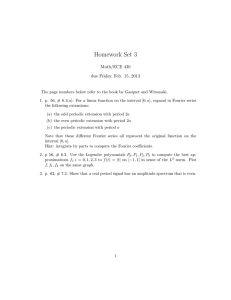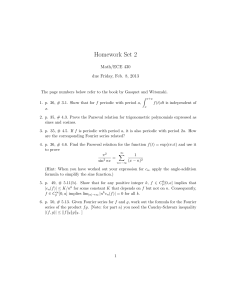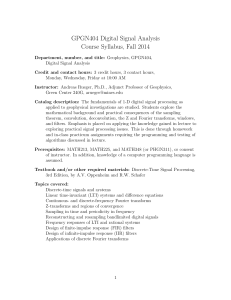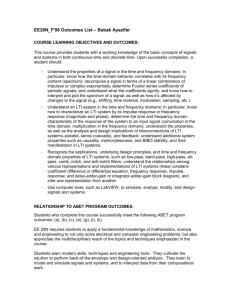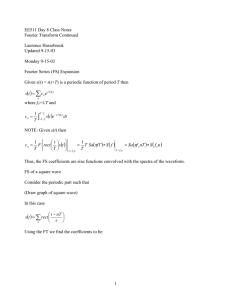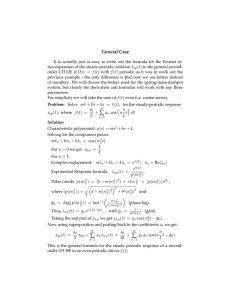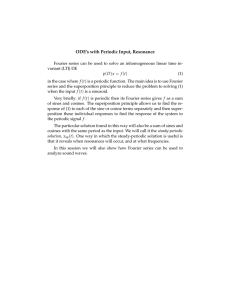Frequency Response and Continuous
advertisement
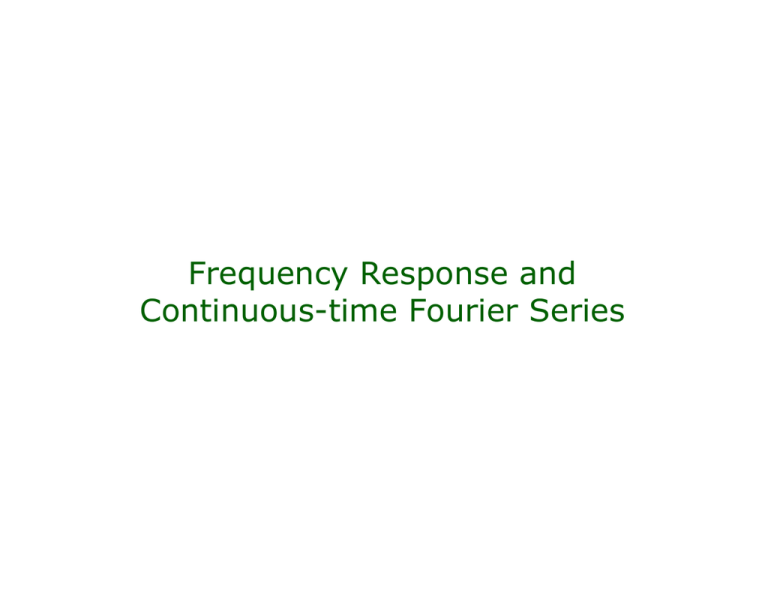
Frequency Response and Continuous-time Fourier Series Recall course objectives Main Course Objective: Fundamentals of systems/signals interaction (we’d like to understand how systems transform or affect signals) Specific Course Topics: -Basic test signals and their properties -Systems and their properties -Signals and systems interaction Time Domain: convolution Frequency Domain: frequency response -Signals & systems applications: audio effects, filtering, AM/FM radio -Signal sampling and signal reconstruction CT Signals and Systems in the FD -part I Goals I. Frequency Response of (stable) LTI systems -Frequency Response, amplitude and phase definition -LTI system response to multi-frequency inputs II. (stable) LTI system response to periodic signals in the FD -The Fourier Series of a periodic signal -Periodic signal magnitude and phase spectrum -LTI system response to general periodic signals III. Filtering effects of (stable) LTI systems in the FD - Noise removal and signal smoothing Frequency Response of LTI systems We have seen how some specific LTI system responses (the IR and the step response) can be used to find the response to the system to arbitrary inputs through the convolution operation. However, all practical (periodic or pulse-like) signals that can be generated in the lab or in a radio station can be expressed as superposition of co-sinusoids with different frequencies, phases, and amplitudes. (An oscillatory input is easier to reproduce in the lab than an impulse delta, which has to be approximated.) Because of this, it is of interest to study (stable) LTI system responses to general multi-frequency inputs. This is what defines the frequency response of the system. We will later see how to use this information to obtain the response of LTI systems to (finite-energy) signals (using Fourier and Laplace transforms) Response of Systems to Exponentials Let a stable LTI system be excited by an exponential input x(t) = Ae "t Here, " and A can be complex numbers! From what we !learned on the response of LTI systems: ! ! The response to an exponential is another exponential y(t) = Be "t x(t) = Ae "t Problem: Determine B ! ! ! ! Response of Systems to Exponentials Consider a linear ODE describing the LTI system as N d k y(t) M d k x(t) " ak dt k =" bk dt k k= 0 k= 0 "t Let x(t) = Ae "t and y(t) = Be Substituting in the ODE we see that ! N ! #b " k M Be "t # ak "k =Ae "t # bk "k ! M k= 0 k " B= k= 0 N A #a " k k= 0 k k= 0 The proportionality constant is equal to the ratio: ! ! M B = A # bk "k k= 0 N #a " k k k= 0 ! bM "M + ....+ b2 "2 + b1" + b0 = aN "N + ....+ a2 "2 + a1" + a0 Response of Systems to Exponentials Surprise #1: The ratio B = H( ") A where ! bM sM + ....+ b2 s2 + b1s + b0 H(s) = aN sN + ....+ a2 s2 + a1s + a0 is the Transfer Function which we have obtained before with Laplace Transforms! ! Response of Systems to Exponentials Surprise #2: j"t # j"t x(t) = Acos( " t) = A e + e If ( ) /2 using linearity y(t) = ( H( j" )e j"t + H(# j" )e# j"t ) /2 ! ! With bit of complex algebra we write H( j" ) = Be j# H(" j# ) = Be" j$ and the response ! y(t) = ( Be j"t +# + Be$ j"t$# ) /2 = Bcos( j"t + # ) ! where B = H( j" ) ! " = #H( j$ ) Response of Systems to Exponentials The ratio B bM ( j" ) M + ....+ b2 ( j" ) 2 + b1 ( j" ) + b0 = H( j" ) = A aN ( j" ) N + ....+ a2 ( j" ) 2 + a1 ( j" ) + a0 is called the Frequency Response ! Observe that H( j" ) is a complex function of " H( j" ) = Re(H( j" )) + j Im(H( j" )) We can graph the FR by plotting: ! ! ! its rectangular coordinates Re H ( j" ) , Im H ( j" ) against or its polar coordinates | H( j" ) | , "H ( j# ) against " ! Polar coordinates are usually more informative ! !! ! ! " Frequency Response Plots Compare rectangular (left) versus polar (right) plots Polar: only low frequency co-sinusoids are passed, the shift in phase is more or less proportional to frequency Rectangular: contains the same information as polar representation. More difficult to see what it does to cosinusoids. Mostly used in computer calculations System classification according to FR Depending on the plot of| H(" ) | we will classify systems into: | H(" ) | Low-pass filters: | H( j" ) |# 0 for | " |> K (*) ! " ! | H(" ) | High-pass filters:| H( j" ) |# 0 for | " |< K ! ! ! ! Band-pass filters:| H( j" ) |# 0 for | " |< K1 and | " |> K 2 | H(" !) | ! ! ! " " In order to ! scale is frequently used. ! plot | H( j" ) |!the logarithmic ! This scale defines decibel units (here we! use log_10) | H( j" ) |dB = 20log | H( j" ) | (*) these plots correspond to the so-called ideal filters, because ! a set of low, high, and band frequencies they keep exactly dB representation of Frequency Response A plot in dB makes it possible to see small values of the FR magnitude| H( j" ) .| This is important when we want to understand the quality of the filter. In particular we can observe the critical values of the frequency for which the character of the filter changes. 1 ! Example: Linear plot of the low-pass filter H( j" ) = 1+ j" ! dB representation of Frequency Response The same function in dB units has a plot: dB representation of Frequency Response Linear plot of the low-pass filter H( j" ) = ! 1 (1+ j" )(100 + j" ) dB representation of Frequency Response … and the plot of the same filter in dB: Response of Systems to Co-sinusoids The FR of an LTI system has the following properties: | H(" j# ) |=| H( j# ) | "H(# j$ ) = #"H( j$ ) Because of this, the response of the LTI system to real sinusoid or co-sinusoid is as follows: ! ! cos("t + # ) | H( j" ) | cos("t + # + $H( j" )) Knowledge of H( j" ) is enough to know how the system ! ! responds to real co-sinusoidal signals This property is what allows compute the FR experimentally ! Response to system to multi-frequency inputs Use linearity to generalize the response of stable LTI systems to multi-frequency inputs y(t) = A1 | H( j"1 ) | cos("1t + #1 + $H( j"1 )) + A2 | H( j" 2 ) | cos(" 2 t + # 2 + $H( j" 2 )) x(t) = A1 cos("1t + #1 ) + A2 cos(" 2 t + # 2 ) ! The system acts on each cosine independently CT Signals and Systems in the FD -part I Goals I. Frequency Response of (stable) LTI systems -Frequency Response, amplitude and phase definition -LTI system response to multi-frequency inputs II. (stable) LTI system response to periodic signals in the FD -The Fourier Series of a periodic signal -Periodic signal magnitude and phase spectrum -LTI system response to general periodic signals III. Filtering effects of (stable) LTI systems in the FD - Noise removal and signal smoothing Signal decompositions in the TD and FD In the Time Domain, a signal is decomposed as a “sum” of time shifted and amplified rectangles In the Frequency Domain, a signal is decomposed as a “sum” of time shifted and amplified co-sinusoids A Frequency Domain representation of a signal tells you how much energy of the signal is distributed over each cosine/sine The different ways of obtaining a FD representation of a signal constitute the Fourier Transform There are 4 categories of Fourier Transforms, and we will study 2: Fourier Series: for periodic, analog signals Fourier Transform: for aperiodic, analog signals The other 2 categories are for discrete-time signals Fourier Series of periodic signals Let x(t) be a “nice” periodic signal with period T0 Using Fourier Series it is possible to write x(t) as ! ! 2# ! "0 = T0 ! $ x(t) = % X[k]e jk" 0 t k=#$ The coefficients X[k] are computed from the original signal as ! 1 X[k] = ! T0 T0 $ ! x(t)e" jk# 0 t dt 0 X[k] is the harmonic function, and k is the harmonic number ! Fourier Example Square wave "0, 0 < t < 0.5 x(t) = # $1, 0.5 < t < 1 Compute coefficients ! 11 X[0] = " x(t)1dt = 0.5 10 1 X[k] = ! $ 1 x(t)e " jk 2 #t dt = 0 0.5 %' j , k odd = & k# '( 0, k even ! $ e" jk 2#t dt = ! 1 e" jk 2 # " e" jk# ) ( " j2k# k = ...,"2,"1,1,2,... Fourier Example Square wave $ $ j "j x(t) = 0.5 + % e j (2k"1)2 #t + % e" j (2k"1)2 #t k=1 (2k "1)# k=1 (2k "1)# $ 2 = 0.5 " % sin(2# (2k "1)t ) k=1 (2k "1)# ! “Proof” of Fourier Series Fact #1: For any integer i T0 " ji# 0 t e dt = T0 if i = 0 , and $ 0 ! T0 " ji# 0 t e dt = 0 $ if i " 0 0 Proof: If a Fourier Series exists then ! ! $ !" 0 t ji ! x(t) = % X[i]e i= #$ " jk# 0 t e Multiply by on both sides $ ! x(t)e" jk# 0 t = ! $ ji# 0 t " jk# 0 t j(i" k )# 0 t X[i]e e = X[i]e % % i= "$ i= "$ “Proof” of Fourier Series Proof (continued): Integrate over a period on both sides T0 $ % x(t)e" jk# 0 t dt = 0 T0 j(i" k )# 0 t X[i] e dt & $ i= "% 0 and use Fact #1 to show that % ! T0 j(i" k )# 0 t X[i] e dt = T0 X[k] & $ i= "% 0 which leads to the Fourier formula ! 1 X[k] = T0 T0 $ 0 x(t)e" jk# 0 t dt Graphical description of a periodic signal as a function of frequency The Frequency Domain graphical representation of a periodic signal is a plot of its Fourier coefficients (FC) Since the coefficients are in general complex numbers, the (polar) representation consists of: 1) a plot of | X[k] | for different k (the magnitude spectrum) k 2)a plot of "X[k] for different ! ! (the phase spectrum) The magnitude spectrum!tells us ! how many frequencies are necessary to obtain a good approximation of the signal Square wave: most of the signal can be approximated using low frequencies, however discontinuities translate into lots of high frequencies System response to periodic signal To find the response of an (stable) LTI system on a periodic signal of period T0 : $ x(t) = ! X[k] = 1 T0 T0 $ x(t)e jk" 0 t X[k]e % "0 = k=#$ " jk# 0 t 2# = 2#f 0 T0 dt, k = ...,"2,"1,0,1,2,... 0 ! We use the system FR and change each signal ! component as follows: frequency ! $ y(t) = $ jk" 0 t H(kj " )X[k]e = % 0 jk" 0 t H[k]X[k]e % k=#$ k=#$ % y(t) = & X[k] | H(kj" ) | e 0 k=$% ! % j(k" 0 t +#H (kj" 0 )) = & | X[k] || H[k] | e k=$% j(k" 0 t +#H [k ]+#X [k ]) Graphical signal/systems interaction in the FD In this way, the interaction of periodic signals and systems in the FD can be seen a simple vector multiplication/vector sum: | H[k] | | X[k] | ! ! = " ! Once we have computed the signal spectrum and system FR, the magnitude spectrum |Y[k] | of the output can be computed in a simple way (compare it with convolution…) ! The output vector phase corresponds to a vector sum "Y[k] = "X[k] + "H[k] ! CT Signals and Systems in the FD -part I Goals I. Frequency Response of (stable) LTI systems -Frequency Response, amplitude and phase definition -LTI system response to multi-frequency inputs II. (stable) LTI system response to periodic signals in the FD -The Fourier Series of a periodic signal -Periodic signal magnitude and phase spectrum -LTI system response to general periodic signals III. Filtering effects of (stable) LTI systems in the FD - Noise removal and signal smoothing Noise Removal in the Frequency Domain From our previous discussion on filters/multi-frequency inputs we observe the following: rapid oscillations “on top” of slower ones in signals can be “smoothed out” with low-pass filters Example: In the signal x(t) = cos(t /2) + cos("t) the high frequency component is cos("t) while the low frequency component is cos(t /2) ! ! ! Noise Removal in the Frequency Domain The response of a low-pass filter to this signal becomes: y(t) = 0.89cos(t /2 " 26.5) + 0.303cos(#t " 72.3) ! The output signal retains the slow oscillation of the input signal while almost removing the high-frequency oscillation Noise Removal in the Frequency Domain A low-frequency periodic signal subject to noise can be seen as a low-frequency cosine superimposed with a high-frequency oscillation. For example consider the following noisy signal: Noise Removal in the Frequency Domain The steady-state response of a low-pass filter (e.g. the RC lowpass filter) to the signal is the following: (This has exactly the same shape as the uncorrupted signal, and we are able to remove the noise pretty well) Noise Removal in the Frequency Domain The use of low-pass filters for noise removal is a widespread technique. Theoretically, we have seen why this technique works for periodic signals However, the same technique works for any signal of finite energy. This is explained through the theory of Fourier/Laplace transforms of signals and systems that we will see next Depending of the type of noise and signal, some filters may work better than others. This leads to the whole subject of “filter design” in signals and systems (…) Noise removal in the Frequency Domain The problem is that as well as the noise we may find: in audio signals: plenty of other high-frequency content in image signals: edges contribute significantly to highfrequency components Thus an “ideal” low-pass filter tends to blur the data E.g. edges in images can become blurred. Observe the output to two different low-pass filters: This illustrates that one has to be careful in the selection of filter (…) Summary Reasons why we study signals in the frequency domain (FD): (a) Oscillatory inputs and sinusoids are easier to implement and reproduce in a lab than an impulse signals (which usually we need to approximate) and even unit steps (b) A pulse-like signal can be expressed as a combination of co-sinusoids, so if we know how to compute the response to a cosinusoid, then we can know what is the response to a pulse-like signal (and to general periodic signals) (c) Once signals and systems are in the FD, computations to obtain outputs are very simple: we don’t need convolution anymore! This is one of the reasons why signal processing is mainly done in the FD. For example, deconvolution (inverting convolutions) is more easily done in the FD (d) The FD can be more intuitive than the TD. For example, how noise removal works is easier to understand in the FD Summary Important points to remember: 1. The output of (stable) LTI systems to a complex exponential, sinusoid or co-sinusoid, resp., is again another complex exponential, sinusoid or co-sinusoid, resp., 2. These outputs can be computed by knowing the magnitude and phase of the Frequency Response H(jw) associated with the LTI system 3. Systems can be classified according to their Frequency Response as low-pass, high-pass or band-pass filters 4. We can approximate a wide class of periodic signals as a sum of complex exponentials or co-sinusoid via a Fourier Series (FS) expansion 5. The FS expansion allows us to see signals as functions of frequency through its (magnitude and phase) spectrum 6. A (stable) LTI system acts on each frequency component of the FS of a periodic signal independently. This leads to fast computations (compare with a possible convolution… ) 7. Low-pass filters are used for signal “smoothing” and noise removal
